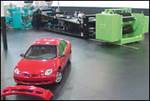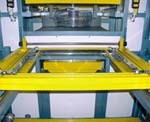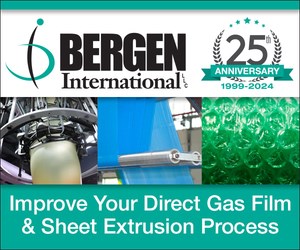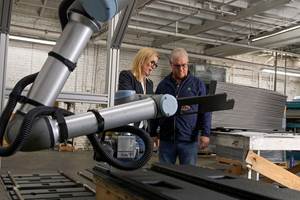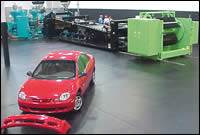How to Thermoform Top-Quality IMD Inserts
Wider adoption of in-mold decorating (IMD) for demanding industries like automotive, appliances, and consumer electronics will require thermoformers to have the right know-how and equipment.
Wider adoption of in-mold decorating (IMD) for demanding industries like automotive, appliances, and consumer electronics will require thermoformers to have the right know-how and equipment. Making precisely formed film inserts is critical for applications with registered print or graphics or an automotive Class A surface.
“The preform shapes and defines the decorative part surface,” comments Jeff Christensen, specialist at the In-Mold Applications Div. of Display Pack, a leading designer and former of IMD preforms. Inserts must fit snugly in the mold cavity and resist tendencies to degrade, wrinkle, thin out, or change color under the influence of heat and pressure during back-molding. Christensen says making IMD preforms requires expertise in films, inks, and thermoforming. Suitable equipment needs state-of-art temperature controls to precisely govern sheet-temperature profile, sheet sag, material distribution, and registration accuracy.
Patrick Griffin, applications specialist at Bayer Polymers, says male tools are preferable for making Class A preforms since they attract less dust that can become embedded in parts. Male tooling also minimizes film wrinkling in complex tool areas, Griffin says. He adds that an intimate interface between film and tool surface is necessary to get efficient heat transfer, so precise die-cutting of IMD inserts to fit the cavity is critical. He favors use of 3D matched-metal dies for this task.
Griffin also advises that films for inserts should have low stress levels and should be brought up to forming temperature in a controlled way for efficient evaporation of residual moisture and ink solvents. Uncontrolled emissions can impair gloss and create flaws in part surfaces, he notes.
Conventional vacuum forming equipment offers maximum registration accuracy of about ±0.020 in., Griffin says. When tighter tolerances are required—e.g., for telecom devices, where the standard is ±0.005 in.—he recommends use of a specialized process that forms inserts with low-temperature, high-pressure air.
Dedicated IMD machine
Jacob Horev, v.p. of equipment supplier ZMD International, notes that registration accuracy is critical if logos, words, or symbols on the film insert are to end up at exactly the right spot on a repeatable basis. ZMD is offering a single-station vacuum former designed specifically for registered IMD inserts, which typically are made out of polycarbonate films.
ZMD’s model V-222DHCG and V-223DHCG machines have forming areas of 24 x 24 and 24 x 36 in., respectively, and use 58 to 87 independently controlled heat zones on both top and bottom. Horev reports strong sales of these machines for IMD of cellular phone housings, cameras, appliance controls, membrane switches, and woodgrain interior automotive panels.
One prerequisite for registered IMD inserts is excellent control of oven and sheet temperatures. The ZMD top heater platen can be adjusted up and down to increase sheet-temperature accuracy, while the bottom heaters provide a fast temperature rise to support the sheet and achieve near-zero sagging, Horev says. Oven temperature is controlled to ±1° F.
In conventional forming equipment, the heating cycle is governed by time, percent power, or sheet sag. ZMD monitors actual sheet temperature with noncontact infrared pyrometers that can “read” the temperature and then automatically initiate the forming cycle when the sheet reaches the target temperature.
Precise temperature control of molds is critical to controlling shrinkage of inserts. Every 5° F variation in mold temperature can cause a 0.001 in./in. change in shrinkage.
ZMD’s machines also minimize distortion of printed graphics by keeping the clamp frame stationary during the heating cycle while moving the heater platens, thus all but eliminating sag. Horev says excessive sag is a major cause of image distortion. In addition, a four-way adjustable pneumatic clamp frame reportedly allows easy setting of sheet position for registration within ±0.005 in.
Related Content
Cobot Creates 'Cell Manufacturing Dream' for Thermoformer
Kal Plastics deploys Universal Robot trimming cobot for a fraction of the cost and lead time of a CNC machine, cuts trimming time nearly in half and reduces late shipments to under 1% — all while improving employee safety and growth opportunities.
Read MoreOMV Technologies Gets New CEO
Kooper brings 33 years of experience in the industrial and consumer packaging industries to OMV--the closed-loop, turnkey, inline extrusion, thermoforming and tooling systems manufacturer.
Read MoreThermoformer Maximizes Productivity with 3D Printing
Productive Plastics has created an extensive collection of 3D printed manufacturing aids that sharply reduce lead times.
Read MoreUS Merchants Makes its Mark in Injection Molding
In less than a decade in injection molding, US Merchants has acquired hundreds of machines spread across facilities in California, Texas, Virginia and Arizona, with even more growth coming.
Read MoreRead Next
Where the Action Is: Decorating with Formable Films
Plastics processors are eyeing form able films as an economical, durable, and environmentally friendly means of producing fully decorated parts right out of the mold.
Read MoreLead the Conversation, Change the Conversation
Coverage of single-use plastics can be both misleading and demoralizing. Here are 10 tips for changing the perception of the plastics industry at your company and in your community.
Read MoreRecycling Partners Collaborate to Eliminate Production Scrap Waste at NPE2024
A collaboration between show organizer PLASTICS, recycler CPR and size reduction experts WEIMA and Conair will seek to recover and recycle 100% of the parts produced at the show.
Read More
